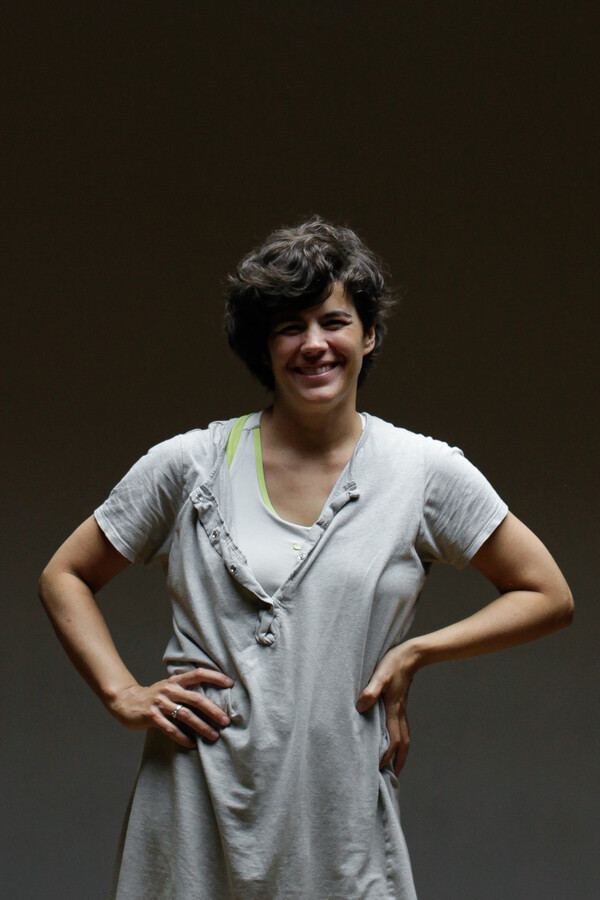Eva Recacha Garcia

Originally from Spain, Eva Recacha is a choreographer, dancer, researcher and educator.
Eva studied contemporary dance at London Contemporary Dance School where she graduated with an MA in Choreography, and she has worked as a pedagogue in HE since 2005, lecturing at LCDS, Trinity Laban, Birkbeck, Candoco and Conservatorio Superior M de Avila (Sp).
As a choreographer, Eva has been commissioned original work for the stage by Sadler’s Wells, The Place, South East Dance, Festival Santa Susana, EDge, and LCDS, as well as site-specific work by Birmingham International Dance Festival, Bloomberg SPACE, Opera Estate Festival Veneto, Fundació LaCaixa, Dies de Dansa and Festival Trayectos. Her artistic work has been supported on a project basis by public funding by the National Lottery through Arts Council England, as well as by the Spanish Embassy in London.
Eva was a Place Prize Finalist for Begin to Begin: A Piece about Dead Ends, and for The Wishing Well, winning the public prize on three occasions. She was a recipient of the Marion North Mentoring Award being consequently mentored by Rui Horta. in 2023, Eva was a TWENTY23 Aerowaves priority artist, touring in UK and Europe with her work Because I Can, made in collaboration with sound artist Alberto Ruiz Soler and the iconic UK performer Lauren Potter.
Eva has been an associate artist at the Place and a Sadler’s Wells Summer University Artist. Her work has appeared in Time Out’s Best of the Year and has been presented in UK and at festivals in Europe.
The relationship between movement, sound and text has been at the core of Eva's choreographic research, both structurally and emotionally. Together with long standing collaborator and sound artist Alberto Ruiz Soler, Eva has developed a distinct dramaturgical style, challenging and probing hierarchies between physical, aural and semantic elements, giving rise to a complex intertwined aesthetic where no one element rules or dictates, instead sharing, supporting, challenging each other to build the structure of the work. Most recently, Eva has begun a new close collaboration with scenographer Kate Lane and together have written and presented a paper on their work at the International Federation of Theatre Research 2025 in Cologne.
Currently working on:
Alongside long-standing collaborator Alberto Ruiz Soler, Eva is currently investigating making work accessible for blind and partially sighted (BPS) audiences. This exploration is part of their creative journey towards the making of their new show, SUR, a piece about friendship and migration currently in R&D. To make this dance-theatre work accessible, Alberto and Eva have been exploring and developing a new way of working with sound and text, which they have named Sound Dramaturgy. As part of this research, Alberto and Eva are exploring ways of embedding audio description in the script of the work as a creative tool (rather than a post-creation access tool).
As part of their investigation into Sound Dramaturgy and with the principle of making work that is accessible to BPS by nature, Alberto and Eva are devising and testing a series of Artist Led workshops to share, explore and test this concept with fellow artists, blind and partially sighted participants, and European migrants.
I am interested in research collaborations in the following areas:
- Relationships between sound/music/text (aural) and dance/movement. Relationship between scenography and movement. In general, anything to do with how the different strands of the medium work together (light, scenography, sound, movement, costumes, camera movement, etc).
- Composition, craft, practice. Structures. Constructions. Forms. Across different art mediums (Music, architecture, dance, literature…).
- Dramaturgy.
- The Absurd. Comedy. Physical comedy.
- Movement in films.
- Collective motions (protests, gatherings, migrations, transportation, travel). Interested in human and non-human motions. Interested in group behaviour, collective endeavours.
- Research into tactile and aural aspects of dance. Exploring a non-ocularcentric approach to dance (across the making, performing and spectating dance).
- Framing/presenting/producing void, absence, reluctance, passivity, pause, silence, stillness, lack of. The power of ‘not-doing’.
- Exploring relations between dance making and literature. Mostly in the use or transposition of literary devices to the arena of dance and vice versa.